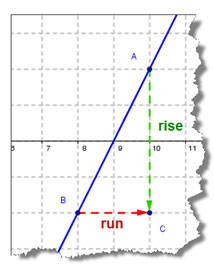
When looking at a line on the coordinate grid we can visualize a right triangle, where our original line is the hypotenuse.
We can use the legs to compute rise over run rise run , the slope of the line. Roofers use rise over run rise run to determine the pitch or slope of a roof.


![]() Use the Slope Rise Run applet below to gather some data to answer a few questions.
Use the Slope Rise Run applet below to gather some data to answer a few questions.
Click on the blanks to check possible answers.
Point A |
Point B |
Rise |
Run |
Slope |
|
| Positive Slope | |||||
| Negative Slope | |||||
| Any Slope | |||||
| Slope of 0 | |||||
| Slope of ∞ |
Answer the following questions.
So, when using the ratio rise over run rise run to compute slope it is important to remember to pay attention to the direction when counting between points.
So, subtracting the y-values from each point gives us the rise, while subtracting the x-values gives us the run. Sounds like a formula, doesn't it?
slope = m = rise over run rise run = (y sub one minus y sub two) over (x sub 1 minus x sub 2) y1 − y2 x1 − x2
It looks like the difference of the y-values of both points is the rise and the difference of the x-values of each point is the run. Remember to use the same point for the first value for both the x and the y.